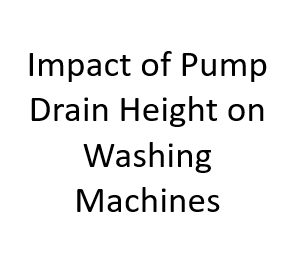Washing machines have become an essential part of modern households, making laundry chores significantly more convenient. But have you ever wondered about the mechanics behind the magic of clean clothes? One crucial aspect of washing machine functionality is the pump drain height. In this blog post, we’ll delve into the significance of pump drain height in washing machines and how it can affect their performance.
The Basics of Washing Machine Drainage
Before we dive into the intricacies of pump drain height, let’s briefly understand how washing machine drainage works. After a laundry cycle, the dirty water needs to be expelled from the drum to ensure your clothes are thoroughly cleaned. This is where the pump drain comes into play. The pump drains the water out of the drum, usually through a hose, and into your home’s plumbing system or a dedicated drainage point.
The Role of Pump Drain Height
The pump drain height refers to the vertical distance between the pump outlet and the drainage point. It might seem like a minor detail, but it plays a crucial role in how efficiently your washing machine operates. The pump drain height can impact water removal, cycle duration, and even the potential for malfunctions. Let’s explore some of the key factors influenced by pump drain height.
Efficient Water Removal:
The pump needs to work against gravity to push water out of the washing machine. The higher the drain point, the harder the pump has to work. If the pump drain height is too high, it can lead to slower drainage, which might result in incomplete rinsing and longer cycle times.
Cycle Duration:
The time it takes for a washing machine cycle to complete can be affected by the pump drain height. A lower drain height allows the pump to expel water more effectively, leading to shorter cycle durations. On the other hand, a higher pump drain height might lead to longer cycles due to reduced drainage efficiency.
Malfunction Risk:
Washing machines are designed with specific pump capabilities. If the pump drain height exceeds the recommended limit, the pump might struggle to expel water effectively. This can lead to strain on the pump motor, increased wear and tear, and even premature breakdowns.
Backflow Prevention:
The height of the pump drain can also impact the risk of backflow, where water from the drainage system flows back into the washing machine. Maintaining an appropriate pump drain height helps prevent this unwanted scenario and ensures the machine functions as intended.
Optimizing Pump Drain Height
To optimize the performance of your washing machine, it’s essential to consider the ideal pump drain height. Manufacturers often provide guidelines in the user manual, specifying the maximum allowable drain height. These guidelines are based on the pump’s capacity and the force it can exert to expel water against gravity.
If you’re installing a washing machine in a new location or renovating your laundry area, keep the following tips in mind:
Follow Manufacturer Guidelines:
Always adhere to the manufacturer’s recommendations for pump drain height. This ensures your washing machine operates efficiently and minimizes the risk of malfunctions.
Avoid Excessive Height:
While it might be tempting to place the washing machine on a pedestal or in a raised area, be cautious of exceeding the recommended drain height. Too much height can lead to reduced drainage efficiency and potential damage to the pump.
Use Proper Drainage:
If your laundry area doesn’t have a suitable drainage point at the recommended height, consider installing a dedicated drainage system that aligns with the manufacturer’s guidelines.
Conclusion
The pump drain height might not be a widely discussed topic, but it plays a crucial role in the efficient operation of washing machines. By understanding the impact of pump drain height on water removal, cycle duration, and potential malfunctions, you can make informed decisions when installing or relocating your washing machine. Always consult the manufacturer’s guidelines and recommendations to ensure your washing machine works optimally and provides you with clean, fresh laundry every time.
